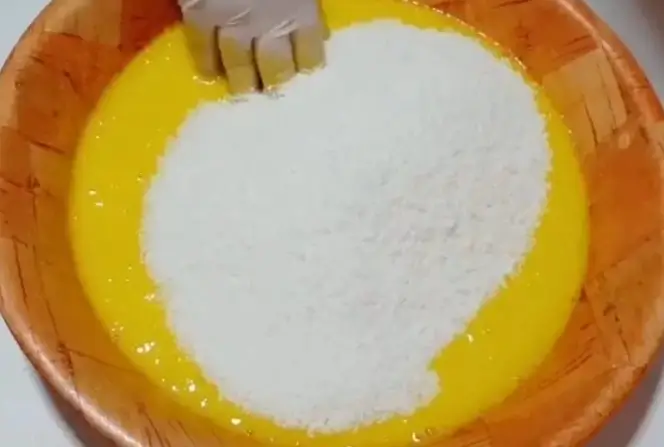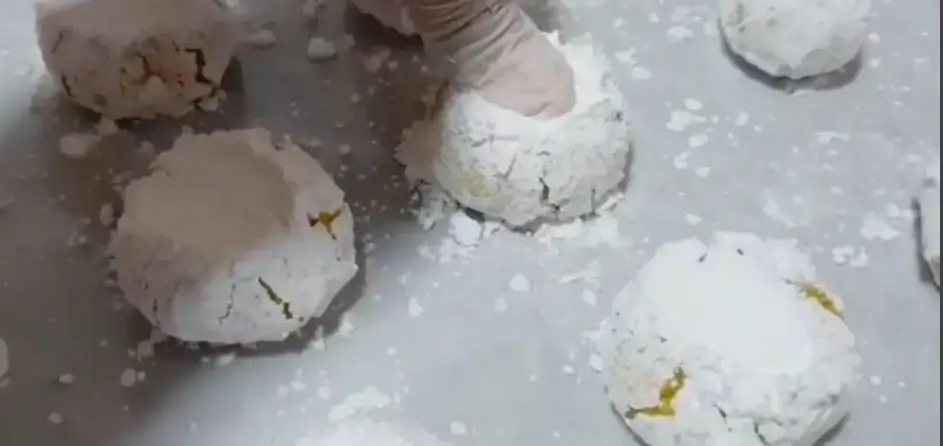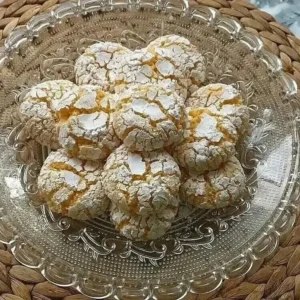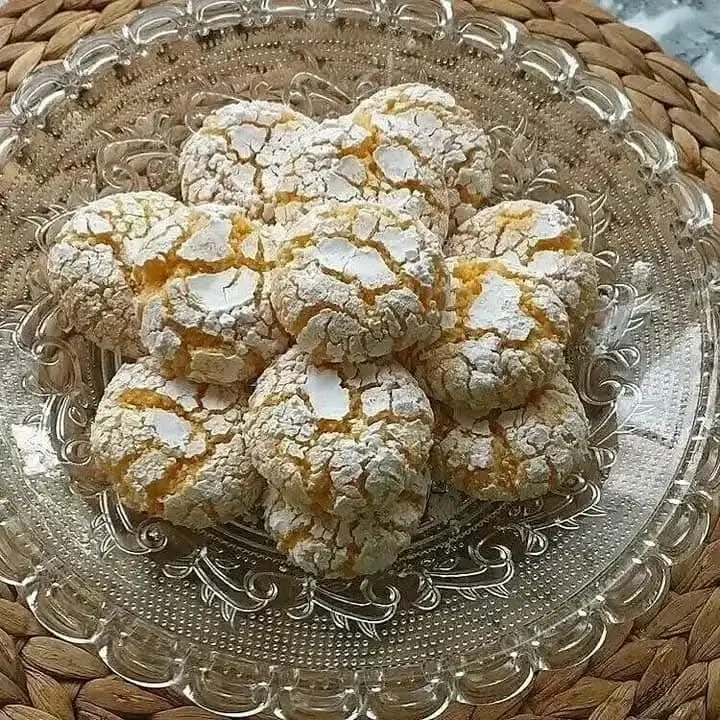Coconut Crinkle Cookies are a delightful treat with a tender, crumbly texture and a rich coconut flavor. These cookies are incredibly easy to make and are perfect for serving with tea, coffee, or as a sweet snack. To achieve the perfect flavor and texture, it’s important to use unsweetened full-fat desiccated coconut for the authentic coconut taste and a soft, chewy interior.
Ingredients of Coconut Crinkle Cookies:
250 grams unsweetened full-fat desiccated coconut
250 grams fine semolina
300 grams granulated sugar
3 large eggs
240 ml vegetable oil
7 grams baking powder
1 teaspoon lemon flavoring or lemon zest
A small pinch of salt
1 tablespoon apricot jam (slightly warmed)
50 grams cornstarch
Powdered sugar for dusting
What is Full-Fat Coconut?
For this recipe, it’s essential to use unsweetened full-fat desiccated coconut. This type of coconut retains its natural oils, contributing to the rich flavor and soft texture of the cookies. Using sweetened or low-fat coconut will result in a less authentic taste and texture, so be sure to use the full-fat version.
Instructions of Coconut Crinkle Cookies:
Step 1: Prepare the Dough
- In a large mixing bowl, whisk the eggs and sugar together until the sugar dissolves and the mixture becomes smooth.
- Add the oil, lemon flavor (or zest), a pinch of salt, and apricot jam. Mix well to combine.
- Stir in the desiccated coconut and cornstarch until fully incorporated.
- Gradually add the semolina, mixing continuously, until the dough is firm and no longer sticky.

Step 2: Shape the Cookies
1. Roll the dough into small balls, about the size of a walnut, and set aside.2. Roll each ball in powdered sugar to coat it thoroughly.
3. Place the sugar-coated balls on a baking sheet lined with parchment paper and gently press them down with your fingers to slightly flatten them.

Step 3: Bake the Cookies
1. Preheat the oven to 180°C (350°F).2. Arrange the cookies on the prepared baking sheet, leaving space between each one.3. Bake with top heat only for about 5-8 minutes, or until cracks begin to appear on the surface.4. Once cracks have formed, turn off the top heat and switch to bottom heat only. Continue baking for an additional 10 minutes, or until the cookies are golden brown on the bottom.5. Remove from the oven and allow the cookies to cool completely before serving.

Tips Serving and Storing:
Serve your Coconut Crinkle Cookies with a hot cup of Moroccan tea or coffee. These cookies can be stored in an airtight container for up to a week, maintaining their soft and crumbly texture.
Try this delicious and easy-to-make cookie recipe today! It’s perfect for any occasion or a sweet treat for yourself and your loved ones.


An Easy and Innovative Way to Make Delicious Coconut Crinkle Cookies
Equipment
- 1 Mixing Bowls
- 2 Measuring Cups One for measuring dry ingredients (like flour and sugar) and one for liquid ingredients
- 1 Measuring Spoons For precise measurements of smaller ingredients like baking powder or flavorings.
- 2 Baking Sheet Depending on the size of your cookies, you may need more than one sheet. Line with parchment paper for easy removal.
- 2 Parchment Paper or Silicone Baking Mat Helps prevent the cookies from sticking to the baking sheet.
- 1 Cookie Scoop or Spoon For portioning the cookie dough into uniform sizes.
- 1 Oven
- 1 Hand Mixer
- 1 Bowl for Sugar To roll the cookie dough balls in powdered sugar before baking.
Ingredients
- 250 g Shredded Coconut Use unsweetened, fatty shredded coconut for the best results
- 250 g Semolina Use fine semolina for a smoother texture in the cookies.
- 1.5 cup Granulated Sugar You can adjust the sweetness by reducing or increasing sugar as per your preference.
- 3 eggs eggs Ensure the eggs are at room temperature for even mixing.
- 1 cup Vegetable Oil
- 7 g Baking Powder
- a few drops drops Lemon Flavoring You can substitute with lemon zest for a fresher flavor
- 1 a pinch Pinch of Salt Balances the sweetness and enhances flavors.
- 1 tbsp Apricot Jam Adds a slight sweetness and moisture; use it sparingly
- 0.5 cup Cornstarch Helps in achieving a softer, chewy texture.
for dusting
- As needed Powdered Sugar Used to coat the cookies before baking for the signature crinkle effect.
FAQ of crinkle cookies
Is butter or oil better for crinkle cookies?
It depends on the texture you prefer:
Butter: Produces a richer, denser cookie with a slightly crispier edge. The flavor is more pronounced due to the milk solids in butter.
Oil: Results in a softer, more tender cookie because it stays liquid at room temperature, keeping the cookies moist for longer.
If you want a more tender and chewy crinkle cookie, go for oil. If you prefer a richer flavor and slightly crisp edges, use butter.
What is the secret to crinkle cookies?
The secret to achieving perfect crinkle cookies lies in the contrast between a dry outer layer and a moist interior. Here are the key factors:
Chilling the dough: Cold dough spreads more slowly, allowing cracks to form as the exterior bakes faster than the inside.
Rolling in powdered sugar: A generous coating of powdered sugar helps highlight the cracks.
Oven temperature: A high initial temperature (around 180°C/350°F) encourages rapid expansion, which leads to pronounced cracks.
What is the best cocoa powder for crinkle cookies?
The best cocoa powder depends on the depth of flavor you want:
Dutch-processed cocoa: Less acidic, darker in color, and has a smoother, more chocolatey taste.
Natural cocoa powder: More acidic, giving a sharper chocolate flavor with a slightly lighter color.
For classic crinkle cookies with deep chocolate flavor, Dutch-processed cocoa is ideal. If you want a brighter, more intense cocoa taste, go with natural cocoa powder.
Why are my crinkle cookies hard?
Hard crinkle cookies usually result from:
Overbaking: Remove them from the oven as soon as the edges are set but the center is still slightly soft.
Too much flour: Excess flour can make cookies dry and tough. Always measure ingredients accurately.
Lack of fat: If you reduce the fat (butter or oil), the cookies can turn out too firm.
Not enough sugar: Sugar helps retain moisture. If reduced too much, cookies may become hard.
To keep your cookies soft, bake them just until cracks form, and let them cool on the baking sheet before transferring them to a wire rack.

